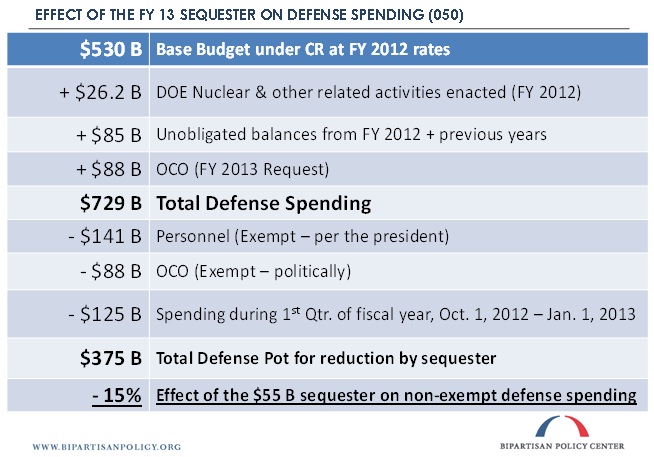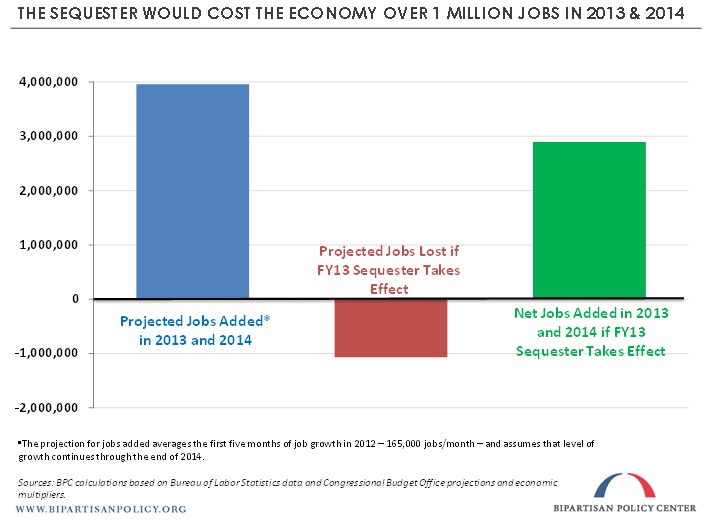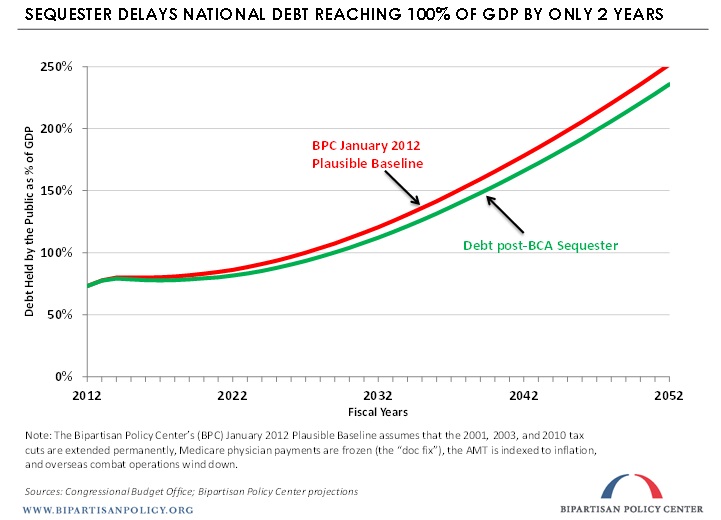The Consequences of the Sequester
UPDATE: The Sequester: What You Need to Know, February 22, 2013
Rebecca Morris contributed to this post.
The sequester (automatic spending cuts totaling more than $1 trillion over a nine-year period) will go into effect on January 2, 2013, but its specter is already starting to impact businesses, and the cuts could cost the U.S. more than one million jobs in 2013 and 2014. If the pending sequester is not addressed by Congress, it will weaken the economy, harm national security, and do virtually nothing to improve the long-term fiscal condition of the United States. After months of study and analysis, these are the conclusions of the Bipartisan Policy Center’s (BPC) Task Force on Defense Budget and Strategy.
On June 7, at BPC, the Task Force’s co-chairs ? former National Security Advisor General James Jones; former Chairman of the Senate Budget Committee and Co-Chair of BPC’s Debt Reduction Task Force Pete Domenici; and former Chairman of the U.S. House Intelligence Committee and former Secretary of Agriculture Dan Glickman ? and other members presented their findings on the pending sequester and how it fits into the context of a sustainable U.S. defense strategy in an age of austerity. The group released a white paper, the first in a sequence of reports, entitled, Indefensible: The Sequester’s Mechanics and Adverse Effects on National and Economic Security.
The paper closely examines the mechanics and effects of the sequester on defense and non-defense spending. It finds that in Fiscal Year (FY) 2013, the indiscriminate $55 billion cut to the defense budget will result in a 15-percent cut to almost every program, project, and activity. Many domestic programs will face similar, though slightly smaller, across-the-board reductions. The Task Force found that the cuts will be incredibly difficult to implement, preclude the execution of any credible defense strategy, and stoke economic uncertainty. At yesterday’s briefing, Senator Domenici described the process as “an absolute fiasco.”

The co-chairs also emphasized the urgency of dealing with the sequester. The economic consequences stemming from the uncertainty have already begun. Furthermore, waiting until the lame duck session of Congress is unwise, given the jam-packed agenda that Congress faces. Task force member Maj. General Arnold Punaro offered specifics: defense contractors are beginning to reduce inventory and curtail hiring, and department heads will slow spending over the coming months in preparation for these arbitrary cuts.
Furthermore, the sequester will be damaging to the industrial base, research and development, and the nation’s long-term growth prospects. Potentially even more important, however, is that the sequester is part of a “fiscal cliff” at the end of this year that could send the economy back into a tailspin. The report projects, based on estimates from the Congressional Budget Office (CBO), that the FY 2013 sequester alone could reduce economic growth by half a percentage point in that year and cost the economy over one million jobs from 2013-2014. Secretary Glickman described these immediate, reckless spending cuts as “a reverse stimulus plan.”

Members of the task force agreed that the Department of Defense (DoD) is in need of sensible reforms. In fact, the group will issue a follow-up report over the next few months, in which it will propose a defense strategy and a series of reforms that will lead to a more efficient defense budget that is consistent with evolving national security and fiscal imperatives. But while the goal of such reforms would be to increase DoD’s “bang for the buck,” the sequester actually makes the Department less efficient by failing to address the existing problems and cutting recklessly across the board.
Additionally, as General Jones pointed out, “the sequester would make president Obama’s new strategic guidance unexecutable.” The arbitrary reductions will eliminate DoD’s discretion to preserve funding for important and efficient missions and capabilities. To confirm and clarify this point for the public, the Task Force calls for OMB to release an account-by-account analysis of the expected effects of the sequester by August 20, 2012.
Despite the economic fallout and the impairment to national security that the sequester will cause, it still does little to improve our deficit problem because it fails to address the major drivers of our debt: an aging population, rising healthcare costs, and inadequate revenues to fund them. In fact, the Task Force found that the sequester will merely delay national debt reaching 100 percent of gross domestic product by two years.

The most responsible solution to this “fiasco” would be a grand bargain, such as those proposed by BPC’s Debt Reduction Task Force (Domenici-Rivlin) and the National Commission on Fiscal Responsibility and Reform (Simpson-Bowles), but Congress and the administration are unlikely to strike such an agreement this year. Thus, the task force recommends that policymakers replace both the defense and non-defense FY 2013 sequester with a strong legislative process to address ? in a meaningful, deliberate, and sustainable fashion ? the structural problems driving our budget woes: entitlement programs and inadequate revenues. To reduce uncertainty, this agreement should be reached sooner rather than later.
By allowing the sequester to go into effect, our national leaders will have effectively ceded the responsibilities of effective governance, leaving our nation without a viable defense strategy and overly vulnerable to circumstance. In the words of General Punaro, “Congress needs to get off their duff.” This is a scenario that can and must be avoided.
Related Posts
- The 2013 Sequester May Not Be What You Think, Updated June 7, 2012
- Everything You Ever Wanted to Know About the Sequester, Updated May 18, 2012
Share
Read Next
Support Research Like This
With your support, BPC can continue to fund important research like this by combining the best ideas from both parties to promote health, security, and opportunity for all Americans.
Give NowRelated Articles
Join Our Mailing List
BPC drives principled and politically viable policy solutions through the power of rigorous analysis, painstaking negotiation, and aggressive advocacy.